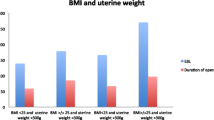Abstract
Obesity is having an increasingly significant impact on health care services across the developed world. Although initially laparoscopic surgery was thought to be contraindicated in cases of obesity, surgeons, including gynaecologists, are now routinely performing laparoscopic surgery on obese patients. Limited research has been conducted into the effect of obesity on outcomes of major laparoscopic pelvic surgery. Some authors report worsening outcomes in obese women having laparoscopic hysterectomies; others suggest that complication rates do not increase, but operating times are longer. Here, we report our experience from 250 total laparoscopic hysterectomies performed for benign, malignant and pre-malignant conditions, and we compare outcomes among normal, overweight, obese and morbidly obese patients. We used a composite score index calculated on the basis of operating and theatre times, estimated blood loss, length of stay and number and severity of complications for our comparisons. Our conclusions suggest that meticulous, consistent surgical technique may produce similar outcomes in normal and obese patients having total laparoscopic hysterectomy, with longer operating/theatre times noted only at BMI levels >40.


Similar content being viewed by others
References
Health Survey for England (2013) http://www.hscic.gov.uk/catalogue/PUB16076
Butland B, Jebb S, Kopelman P, et al (2007) Tackling obesities: future choices – project report (2nd). London: Foresight Programme of the Government Office for Science. https://www.gov.uk/government/uploads/system/uploads/attachment_data/file/287937/07-1184x-tackling-obesities-future-choices-report.pdf
Bamgbade OA, Rutter TW, Nafiu OO, Dorje P (2007) Postoperative complications in obese and non-obese patients. World J Surg 31:556–561
Lamvu G, Zolnoun D, Boggess J, Steege JF (2004) Obesity: physiologic changes and challenges during laparoscopy. Am J Obstet Gynecol 191:669–674
Siedhoff MT, Carey ET, Findley AD, et al. (2012) Effect of extreme obesity on outcomes in laparoscopic hysterectomy. J Minim Invasive Gynecol 19:701–707
Chopin N, Malaret JM, Lafay-Pillet MC, et al. (2009) Total laparoscopic hysterectomy for benign uterine pathologies: obesity does not increase the risk of complications. Hum Reprod 24:3057–3062
Osler M, Daugbjerg S, Frederiksen BL, Ottesen B (2011) Body mass and risk of complications after hysterectomy on benign indications. Hum Reprod 26:1512–1518
Clavien PA, Barkun J, de Oliveira ML, et al. (2009) The Clavien-Dindo classification of surgical complications: five-year experience. Ann Surg 250:187–196
Erekson EA, Yip SO, Ciarleglio MM, Fried TR (2011) Postoperative complications after gynecologic surgery. Obstet Gynecol 118:785–793
Donnez O, Jadoul P, Squifflet J, Donnez J (2009) A series of 3190 laparoscopic hysterectomies for benign disease from 1990 to 2006: evaluation of complications compared with vaginal and abdominal procedures. BJOG 116:492–500
Bonilla DJ, Mains L, Rice J, Crawford B 3rd (2010) Total laparoscopic hysterectomy: our 5-year experience (1998-2002). Ochsner J 10:8–12
NHS Institute for Innovation and Improvement (2013) Evaluation of the Productive Operating Theatre Programme http://www.institute.nhs.uk/quality_and_value/productivity_series/the_productive_operating_theatre.html
Heinberg EM, Crawford BL 3rd, Weitzen SH, Bonilla DJ (2004) Total laparoscopic hysterectomy in obese versus nonobese patients. Obstet Gynecol 103:674–680
Camanni M, Bonino L, Delpiano EM, et al. (2010) Laparoscopy and body mass index: feasibility and outcome in obese patients treated for gynecologic diseases. J Minim Invasive Gynecol 17:576–582
George A, Eisenstein D, Wegienka G (2009) Analysis of the impact of body mass index on the surgical outcomes after robot-assisted laparoscopic myomectomy. J Minim Invasive Gynecol 16:730–733
Ghezzi F, Cromi A, Bergamini V, et al. (2006) Laparoscopic management of endometrial cancer in nonobese and obese women: a consecutive series. J Minim Invasive Gynecol 13:269–275
Bai SW, Lim JH, Kim JY, et al. (2002) Relationship between obesity and the risk of gynecologic laparoscopy in Korean women. J Am Assoc Gynecol Laparosc 9:165–169
Acknowledgments
This project was supported by a grant (“Inspire” grant) from the University of Liverpool.
Author information
Authors and Affiliations
Corresponding author
Ethics declarations
All procedures followed were in accordance with the ethical standards of the responsible committee on human experimentation (institutional and national) and with the Helsinki Declaration of 1975, as revised in 2008. Informed consent was obtained from all patients for being included in the study.
Conflict of interest
The authors declare that they have no conflict of interest.
Rights and permissions
About this article
Cite this article
Minas, V., Ventii, C., Murray, N. et al. Total laparoscopic hysterectomy for benign, malignant and pre-malignant gynaecological pathology: relation between surgical outcome and body mass index. Gynecol Surg 13, 493–497 (2016). https://doi.org/10.1007/s10397-016-0968-y
Received:
Accepted:
Published:
Issue Date:
DOI: https://doi.org/10.1007/s10397-016-0968-y




